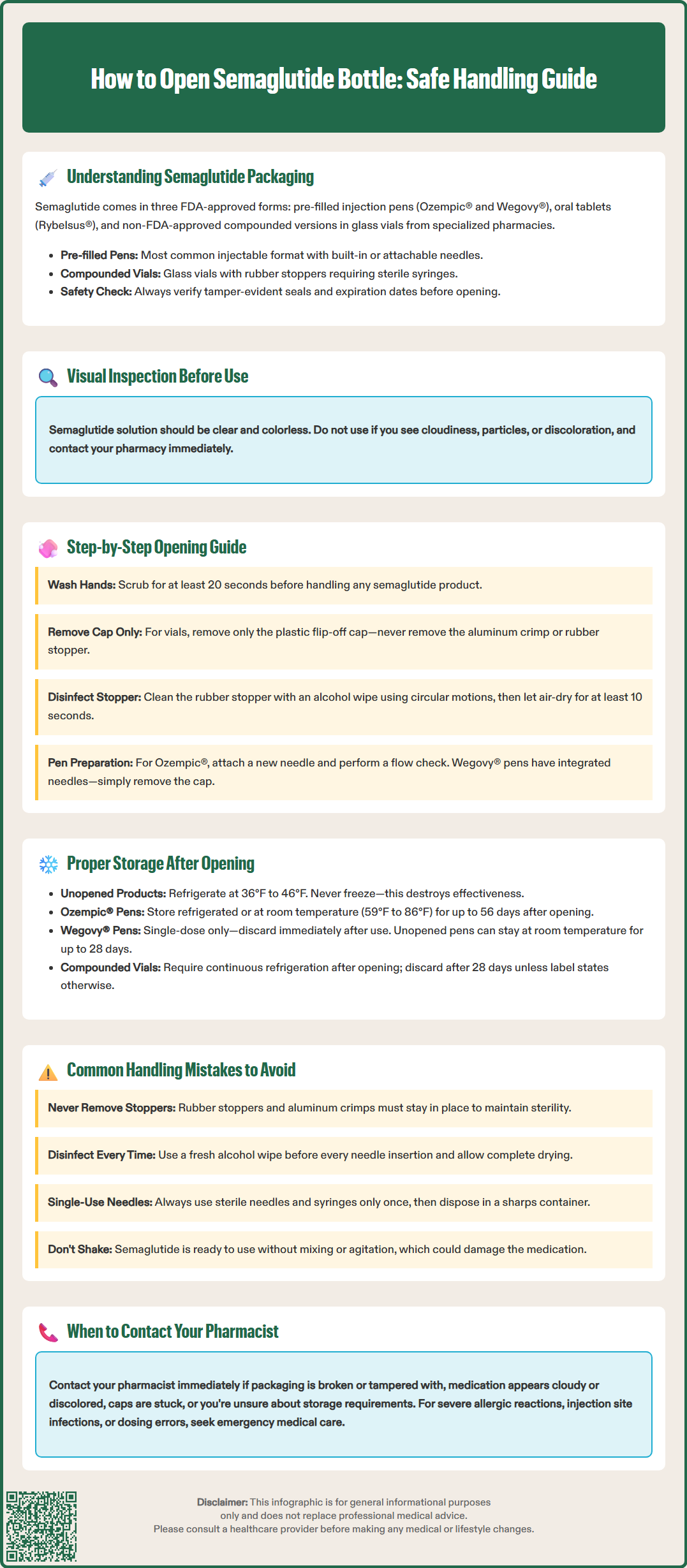LOSE WEIGHT WITH MEDICAL SUPPORT — BUILT FOR MEN
- Your personalised programme is built around medical care, not willpower.
- No generic diets. No guesswork.
- Just science-backed results and expert support.
Find out if you’re eligible

How to open semaglutide bottle correctly depends on which FDA-approved formulation you've been prescribed. Semaglutide is available as pre-filled injection pens (Ozempic® and Wegovy®) and oral tablets (Rybelsus®), each with distinct packaging. Compounded semaglutide may come in glass vials with rubber stoppers. Understanding your specific product type is essential for safe handling and administration. Proper opening technique maintains medication sterility, prevents contamination, and ensures therapeutic effectiveness. This guide provides step-by-step instructions for safely accessing your semaglutide medication, proper storage after opening, and when to seek pharmacist guidance.
Quick Answer: Semaglutide packaging varies by formulation: pre-filled pens require pulling off caps (not twisting), while compounded vials need only the plastic flip-off cap removed—never remove the rubber stopper or aluminum crimp.
Semaglutide is available in specific FDA-approved formulations in the United States, each with distinct packaging designed for specific administration routes. The FDA-approved forms include pre-filled injection pens (Ozempic® and Wegovy®) and oral tablets (Rybelsus®). Understanding which type you have been prescribed is essential for proper handling and administration.
Pre-filled pens represent the most frequently dispensed injectable format. These devices come as sealed, ready-to-use injection systems with pull-off pen caps rather than removable bottle tops. The medication remains sealed within the pen cartridge. Ozempic® is a multi-dose pen requiring needle attachment before each use, while Wegovy® is a single-dose pen with an integrated needle.
Compounded semaglutide (which is not FDA-approved) may be available through specialized pharmacies, typically in glass vials with rubber stoppers secured by aluminum crimps with plastic flip-off caps. These compounded products should only be obtained from state-licensed pharmacies under prescriber direction when FDA-approved products are not appropriate. The vial design allows healthcare providers or patients to withdraw individual doses using sterile syringes, making proper opening technique critical for maintaining sterility.
Regardless of formulation, all semaglutide products should arrive sealed with tamper-evident packaging. Before attempting to open any semaglutide container, verify that all seals are intact, check the expiration date printed on the label, and inspect the solution for clarity. Semaglutide solution should appear clear and colorless; any cloudiness, particles, or discoloration indicates the product should not be used and requires pharmacy consultation.
For patients prescribed compounded semaglutide vials, proper opening technique ensures medication sterility and prevents contamination. Begin by washing your hands thoroughly with soap and water for at least 20 seconds, then dry them completely with a clean towel. Gather all necessary supplies: the sealed vial, alcohol wipes, and if you will be drawing a dose immediately, your prescribed syringe and needle.
Remove only the plastic flip-off cap covering the vial top by gently pulling it straight up. This exposes the rubber stopper, which is held in place by an aluminum crimp. Do not attempt to remove the aluminum crimp or the rubber stopper – these components are designed to remain in place throughout the vial's use. Immediately cleanse the exposed rubber stopper by wiping it firmly with a new alcohol prep pad using a circular motion from center outward. Allow the alcohol to air-dry for at least 10 seconds—this drying time is essential for antimicrobial effectiveness.
For Ozempic® multi-dose pens, pull the pen cap straight off (do not twist). Attach a new, unused needle by screwing it on until secure. Remove both the outer and inner needle caps. For first-time use, perform a flow check as directed in the Instructions for Use. Set your prescribed dose following the manufacturer's instructions. After injection, properly dispose of the needle in an FDA-cleared sharps container and replace the pen cap.
For Wegovy® single-dose pens, simply pull the pen cap straight off. The pen has an integrated needle and is ready to use – do not attempt to attach a separate needle. Follow the specific Instructions for Use provided with your prescription.
If you're unsure about proper technique, contact your healthcare provider or pharmacist before attempting to use the medication. Always follow the official Instructions for Use that came with your specific product.

Once opened, semaglutide requires specific storage conditions to maintain stability and therapeutic effectiveness. According to FDA-approved labeling, unopened semaglutide pens must be refrigerated at 36°F to 46°F (2°C to 8°C) until first use. After opening, storage requirements vary by product formulation.
For Ozempic® multi-dose pens, after first use, the pen may be stored either in the refrigerator (36°F to 46°F) or at room temperature (59°F to 86°F or 15°C to 30°C) for up to 56 days. Keep the pen cap on when not in use and store in the original carton to protect from light. Never store pens with needles attached, as this can cause air bubbles, medication leakage, or needle contamination. Discard the pen 56 days after first use, even if medication remains.
Wegovy® pens are single-dose only and should be discarded after use in an FDA-cleared sharps container. Unopened Wegovy® pens may be kept at room temperature (59°F to 86°F) for up to 28 days before use if needed.
Compounded semaglutide vials typically require continuous refrigeration after opening. Follow the beyond-use date provided by your pharmacy, which is prominently displayed on the vial label. Generally, multi-dose vials with preservatives should not be used more than 28 days after first puncture, per CDC guidance, unless specifically labeled otherwise by the pharmacy.
Never freeze any semaglutide product—freezing destroys the medication's molecular structure and renders it ineffective. If accidental freezing occurs, discard the product and obtain a replacement. Protect all semaglutide products from direct sunlight and excessive heat. When traveling, use insulated medication travel cases with ice packs (ensuring the medication does not directly contact ice) to maintain appropriate temperature ranges, and follow product-specific time limits for room temperature storage.
Several handling errors can compromise semaglutide safety and effectiveness. One frequent mistake involves attempting to remove the rubber stopper or aluminum crimp from vials entirely. These components are designed to remain in place throughout the vial's use; removing them would expose the medication to environmental contaminants and bacteria. The rubber stopper serves as a self-sealing barrier that maintains sterility between doses when properly punctured with sterile needles.
Another common error is inadequate alcohol disinfection of the rubber stopper before each needle insertion. Some patients wipe the stopper only during initial opening, then repeatedly puncture it without cleansing between doses. This practice introduces skin bacteria and environmental microorganisms into the vial, potentially causing contamination. The rubber stopper must be cleansed with a fresh alcohol wipe before every single needle insertion, allowing adequate drying time.
Reusing needles or syringes represents a serious safety hazard. Each syringe and needle must be sterile and used only once, then disposed of immediately in an FDA-cleared sharps container. Reusing injection supplies increases infection risk, causes needle dulling that makes injections more painful, and can introduce contaminants into the vial. This applies to both pen needles and syringes used with vials.
Patients sometimes make the mistake of storing opened products outside recommended temperature ranges. Temperature extremes can affect medication stability. Always maintain storage conditions within the ranges specified in your product's labeling. Additionally, never shake semaglutide vigorously—semaglutide solutions are ready to use and do not require mixing or agitation.
Several situations warrant immediate pharmacist consultation regarding semaglutide handling and access. Contact your pharmacy if you receive a semaglutide product with broken, missing, or tampered seals. Compromised packaging may indicate contamination or improper storage during shipping. Similarly, if the medication appears cloudy, discolored, contains visible particles, or has been frozen, do not use it—return it to your pharmacy for replacement.
If you experience difficulty removing caps or seals that seem stuck or require excessive force, stop and contact your pharmacist rather than risk damaging the container or injuring yourself. Manufacturing variations occasionally occur, and pharmacists can provide guidance or exchange problematic units. Never use tools like pliers or knives to force open medication containers, as this can cause glass breakage, medication spillage, or contamination.
Uncertainty about storage requirements after opening justifies pharmacist consultation, particularly for compounded formulations that may have specific stability limitations. If you accidentally left your semaglutide at room temperature or refrigerated when contrary to instructions, your pharmacist can advise whether the medication remains safe to use based on time and temperature exposure.
Additionally, contact your pharmacist if you need supplies for administration, such as appropriate syringes, needles, alcohol wipes, or sharps containers. Pharmacists can ensure you receive the correct gauge needles and syringe sizes for your prescribed dose. If you're transitioning between semaglutide formulations, your pharmacist can provide essential education on the different handling requirements.
Seek immediate medical attention for signs of severe allergic reaction (difficulty breathing, facial swelling, severe rash), injection site infection, or suspected dosing errors. For compounded semaglutide products, remember these are not FDA-approved and should only be obtained from state-licensed pharmacies under prescriber direction. Finally, if you have physical limitations affecting your ability to handle semaglutide containers, discuss this with your pharmacist, who may recommend alternative formulations or adaptive devices to facilitate safe medication access.
No, never remove the rubber stopper or aluminum crimp from semaglutide vials. Only remove the plastic flip-off cap, then cleanse the exposed rubber stopper with alcohol before each use. The rubber stopper remains in place as a self-sealing barrier that maintains sterility between doses.
Pull the pen cap straight off without twisting. For Ozempic multi-dose pens, attach a new needle by screwing it on securely. Wegovy single-dose pens have integrated needles and are ready to use after removing the cap—do not attempt to attach a separate needle.
Ozempic pens may be used for up to 56 days after first use when stored properly (refrigerated or at room temperature 59°F to 86°F). Wegovy pens are single-dose only. Compounded semaglutide vials typically should not be used more than 28 days after first puncture unless specifically labeled otherwise by your pharmacy.
All medical content on this blog is created using reputable, evidence-based sources and is regularly reviewed for accuracy and relevance. While we strive to keep our content current with the latest research and clinical guidelines, it is intended for general informational purposes only.
This content is not a substitute for professional medical advice, diagnosis, or treatment. Always consult a licensed healthcare provider with any medical questions or concerns. Use of this information is at your own risk, and we are not liable for any outcomes resulting from its use.